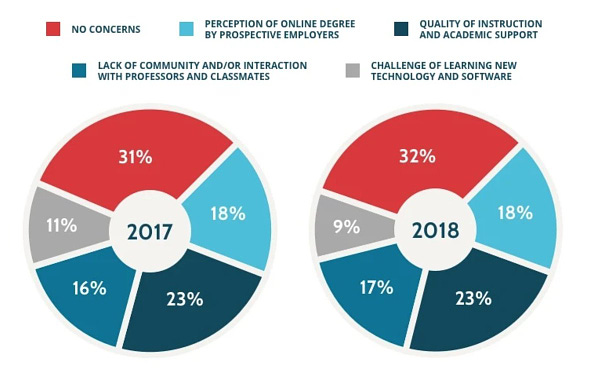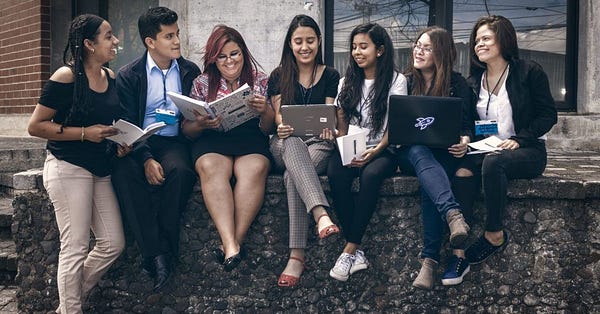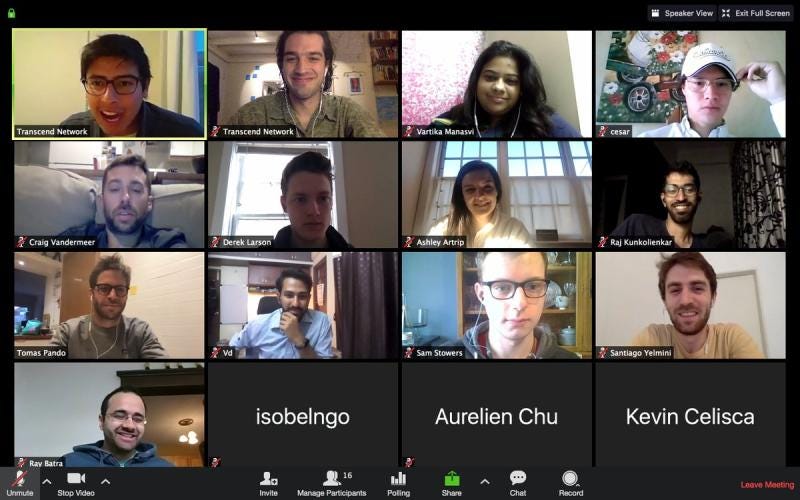Rescuing Human Education, and how tech-enabled learning is missing... 👭 Transcend Newsletter XXII
Exploring the human components of education that new tech-enabled organizations are missing - or rebuilding for a new medium.
This week we are exploring how we might bring the past into new technology-enabled presents and futures - read on more curated comments, analysis, news and updates on our Fellowship! This week’s analysis was co-written with Charlotte Parker, and supported by the great insights from Liz Fernandes and Shane Dabor. Many thanks to all who made this possible!
Like what you read? Got any Twitter friends that would love it too? Send them our newsletter!
tl;dr: in this transition towards technology-enabled education pathways, we’ve lost some “human” components of education - we look at these and how organizations are thinking of re-incorporating them into a new medium.

What’s going on here?
Globally, more and more learning is happening online, and enabled by technology in multiple other ways - both through new projects and organizations as well as existing universities transforming their models.
We’re moving from the sitting-at-a-desk school predicated on interaction with other people to learning that can happen with just you, yourself, and I - and a computer, tablet, or phone. Is that an automatic loss? In my in-person college experience, I had those droning professors or the self-centered classmates who detracted from the learning experience, rather than contributing to it. I was probably on my computer reading fashion blogs in my econ 101 lecture when I could have been learning how to code on my computer during that time instead. But I also had those lightbulb moments - when a human explained something to me across the seminar table, or asked me the question in tutoring that unlocked what was missing in my understanding of a concept.
This transition begs the question of what is inherently “human” about education and teaching, and what are the elements that we are missing in this transition towards increasingly tech-enabled education? There are some components of the physical, structured learning experiences that have started to disappear from the design of tech-enabled learning pathways: the physical interactions among students, the serendipity and creativity that can be found in small conversations and shared experiences, the experience-based learning opportunities, peer learning opportunities in the classroom, greater variance in skill levels and learning styles, visibility into other students’ work, teacher’s ability to improvise and adapt the instruction...
What’s more, many of these new modes of interaction directly shape the experience - Shane Dabor proposes as an analogy the difference between learning a language on an app vs learning it in a country where you may encounter experiences that may significantly alter the learning paths.
Technology has sought to increase access to many of these experiences, but the scope and range of interactions among students have been fairly limited to date. How will the old ways be brought into our new medium to drive more adoption from students?



Why should we care?
If we accept that 68% of students are concerned about online learning (community interaction, reliable certificates or a great user experience), then the idea that new providers will have to transform previous parts of the education experience (what we’ve called human education components) and adapt it to a new set of media becomes really interesting. This thought is also particularly relevant to the world of work, as the new paradigm of remote work has left a large share of the workforce feeling lonely and disconnected.
The Future of Human Education
So what can the new tech-enabled media offer? And how might we bring these human educational components to it? We are going to focus on 3 important aspects:
Cost reduction - the new tech-enabled learning programs are differentiated in their ability to lower the barriers of access through technology.
Self-paced nature - what many have been quick to discount (due to the high failure rates of MOOCs in the last decade), is actually an important benefit to the millions of citizens with some college credit and no degree. Having the ability to complement a part or full-time job with part-time learning is a uniquely beneficial component of tech-enabled learning. How can self-paced programs still foster connection among students?
Differentiated instruction - technology’s ability to differentiate among students and deliver a uniquely tailored curriculum may just be in its infancy, but is one of the most promising lines of work ahead. Teachers vs Tech by Daisy Christodoulou can serve as a starting point for understanding how technology may augment the work of teachers, not eliminate their work.

Projects in the space
There’s a few important lines of work that we’ll highlight:
1. Differentiated instruction
Smart Sparrow uses AI to create adaptive learning technology that, in their words, “aims to emulate and support (not replace!) the talents of great educators to provide the best possible learning experience for every single student.” Liz Fernandes, an instructional designer, points out that this is an application of technology to address the classroom teacher’s inherent challenge: creating differentiated learning experiences for large groups of students who may all be at different levels of understanding.
Programa Valentina: focuses on tackling high rates of youth unemployment in Latin America through project-based training in “soft” skills like teamwork and proactivity as well as basic tech skills. It rigorously screens candidates, uses project-based learning and self-teaching based on students’ interests, and then leverages a system of over 1000 data points to track skills mastery through the job placement process.
Pathstream builds accessible digital skills career programs using both in-person, virtual-only, and blended models. The instruction is driven by both differentiated pathways and peer connection (“It’s really important to have someone shepherding you through the learning experience”, says Fernandes), while grounded in effective instructional design.
2. Blended models
Minerva Schools: the Minerva model takes the instruction online while maintaining the student experience and social interactions offline, which leads to a set of connections, experiences and learning that is hard to model.
Flatiron: as highlighted in the latest CSEd newsletter, Flatiron leads the way in the blended model and the interactions it can promote onsite to lead to better outcomes (a model adopted by Eskwelabs too) - other bootcamps are experimenting with plans to better address the emotional student journey.
Thinkful: Founded in 2012 at the dawn of the era of online boot camps, Thinkful (now a Chegg service) was one of the first companies to pair students with a coach and mentor, a model also used by Arizona State University’s online programs.
3. Physical spaces
Shift_Up: building learning gyms, both for independent learners but more importantly to host students from existing programs and bootcamps, give them access to a community, learning coaches and space to foster new types of interactions: “self-paced at home, but learning together IRL @LearningGyms”
Learnlife: spaces and learning guidance to lifelong learners, and expanding globally.
NewCampus: physical campus with a focus on providing access to workshops and content as well as guiding lifelong learners.


What do you think? We’d love to get your thoughts: please leave a comment or reply to this email!

🤦♀️As we enter Women’s History Month, it’s imperative we remember the challenges that must be addressed in the world of learning and work: women earn better grades than men across levels of education, yet high-achieving men are twice as likely to be called back after a job interview than high-achieving women. We’d love to hear about more programs and initiatives tackling this inequality and bias in hiring.
📅Last week we talked about the 36M people in the US that hold some college credits but no degrees. One strong solution might come through fully-online degrees, such as the recently announced EdX MicroBachellors program.
💻Check out the most comprehensive analysis of the state of bootcamps in 2020, brought to you by James Gallagher of Career Karma.
💸Transcend Fellow Sam Stowers (Slumber) just made his commitment to Founder’s Pledge, agreeing to donate a portion of the liquidity obtained from an exit to charity. FP does not charge fees and are a great resource for founders, check out their work!
✍️Cassidy Leventhall (University Ventures) replied to our last newsletter on the Placement Economy with her fascinating ecosystem map of players bridging this gap. Check it out to learn about innovative approaches to scaling placement.


👋Looking for opportunities or want to say hi? Introduce yourself here!

All the updated job opportunities can be found on our Job Board!
Venture Associate - EdConnective
Social Media Manager - Edutive
Software Engineer and Head of Coaching - CareerCopilots
Fill out this form if you are looking to hire or get hired, and check out our job board for updated openings.

The current cohort of the Transcend Fellowship came to an end last week! We’ve been incredibly humbled to work with 19 amazing founders in this space (many have been featured in our analysis).
Make sure to keep an eye on this newsletter for future announcements - we’ll be doing another cohort this year and will open up pre-registrations soon!

👀Learn more about our Transcend fellowship!
Thanks for reading another week! For any feedback, requests or ideas, reply to this email.
Please take a minute to share if you found this newsletter interesting!
Alberto(alberto@transcend-network.com) & Michael (michael@transcend-network.com)


